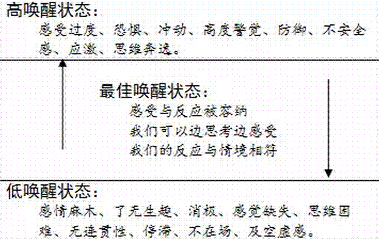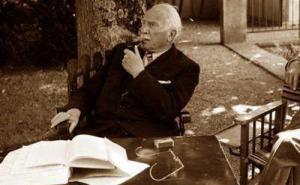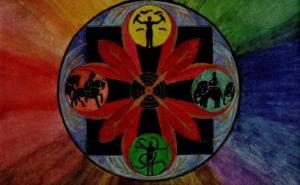www.nmgpsy.com内蒙古心理网
 Psychologist C.G. Jung (1875-1961) was one of the founding fathers of modern
psychoanalysis, and in The Red Book, he developed his principal theories of
archetypes, the collective unconscious and the process of individuation. Earlier
this year, W.W. Norton released a facsimile edition of this
never-before-published tome — The Red Book of C.G. Jung. The book is a hybrid of
text and image, based on Jung’s obsessive exploration of his own interior life.
Psychologist C.G. Jung (1875-1961) was one of the founding fathers of modern
psychoanalysis, and in The Red Book, he developed his principal theories of
archetypes, the collective unconscious and the process of individuation. Earlier
this year, W.W. Norton released a facsimile edition of this
never-before-published tome — The Red Book of C.G. Jung. The book is a hybrid of
text and image, based on Jung’s obsessive exploration of his own interior life.
In honor of the event, the Rubin Museum of Art opened an exhibition of the mandalas that form the graphic heart of the book, The Red Book of C.G. Jung: Creation of a New Cosmology, and is presenting a series of talks entitled “The Red Book Dialogues,” which will run into the New Year.
The “Dialogues” pair artists, writers and other guests from a variety of professional backgrounds with Jungian analysts to discuss the book and specific images within this “holy grail of the unconscious.” Each guest responds to an image, and each analyst offers an on-the-spot reaction to what that response says about the viewer. The “Dialogues” were conceived by Rubin Museum producer Tim McHenry, who calls them “part guided association, part theater, and part good old fashioned conversation.”
WNYC’s “Talk to Me” is featuring notable selected dialogues from the series.

Talk to Me: Filmmaker Charlie Kaufman
By WNYC Culture | Mon, Nov 16, 2009
Last Saturday night’s entry in the Rubin Museum’s “Red Book Dialogues” series
featured award-winning screenwriter, director and producer Charlie
Kaufman (Being Malkovich, Adaptation,Eternal Sunshine of the Spotless ) and
San Francisco-based Jungian analyst John .
Listen to it here:
 Psychologist C.G. Jung (1875-1961) was one of the founding fathers of modern
psychoanalysis, and in The Red Book, he developed his principal theories of
archetypes, the collective unconscious and the process of individuation. Earlier
this year, W.W. Norton released a facsimile edition of this
never-before-published tome — The Red Book of C.G. Jung. The book is a hybrid of
text and image, based on Jung’s obsessive exploration of his own interior life.
Psychologist C.G. Jung (1875-1961) was one of the founding fathers of modern
psychoanalysis, and in The Red Book, he developed his principal theories of
archetypes, the collective unconscious and the process of individuation. Earlier
this year, W.W. Norton released a facsimile edition of this
never-before-published tome — The Red Book of C.G. Jung. The book is a hybrid of
text and image, based on Jung’s obsessive exploration of his own interior life.In honor of the event, the Rubin Museum of Art opened an exhibition of the mandalas that form the graphic heart of the book, The Red Book of C.G. Jung: Creation of a New Cosmology, and is presenting a series of talks entitled “The Red Book Dialogues,” which will run into the New Year.
The “Dialogues” pair artists, writers and other guests from a variety of professional backgrounds with Jungian analysts to discuss the book and specific images within this “holy grail of the unconscious.” Each guest responds to an image, and each analyst offers an on-the-spot reaction to what that response says about the viewer. The “Dialogues” were conceived by Rubin Museum producer Tim McHenry, who calls them “part guided association, part theater, and part good old fashioned conversation.”
WNYC’s “Talk to Me” is featuring notable selected dialogues from the series.

www.nmgpsy.com内蒙古心理网







